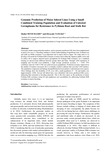Genomic Prediction of Maize Inbred Lines Using a Small Combined Training Population and Evaluation of Untested Germplasms for Resistance to Pythium Root and Stalk Rot
JARQ : Japan Agricultural Research Quarterly
| ISSN | 00213551 |
|---|---|
| 書誌レコードID(総合目録DB) | AA0068709X |

本文フルテキスト
jarq58-3_151-164.pdf1.41 MB
Genotypic studies using molecular markers, such as genomic prediction (GP), have been implemented in maize (Zea mays L.) breeding, leading to a better understanding of significant traits. Pythium root and stalk rot (RSR) resistance is an important trait in maize bred in Japan. The study aims to (1) develop a GP model for Pythium RSR resistance in maize bred within the Japanese public sector and (2) utilize GP to analyze untested maize germplasms for Pythium RSR resistance via a combined training set derived from different heterotic groups (dent and flint). Through 1000 repetitions of sampling and five-fold cross-validation, a high average prediction accuracy (r = 0.695, 95% confidence interval: 0.682-0.708) was achieved across populations. Prediction accuracy improved as the number of markers increased, but it eventually reached a plateau that exceeded 1000 markers. The population component and linkage disequilibrium between markers confirmed previous reports. These findings show the feasibility of GP, even with a small population (N = 41) and marker size (approximately 1000). Several old inbred lines were identified with lower predicted RSR scores, indicating their potential as breeding materials. This is the first report on the prediction of maize Pythium RSR resistance using GP and emphasizes new possibilities for addressing Pythium RSR resistance in maize breeding.
| 刊行年月日 | |
|---|---|
| 作成者 | Shohei MITSUHASHI Hiroyuki TAMAKI |
| 著者キーワード | best linear unbiased prediction Zea mays L. |
| 公開者 | Japan International Research Center for Agricultural Sciences |
| 受付日 | 2023-08-07 |
| 受理日 | 2023-12-09 |
| オンライン掲載日 | |
| 巻 | 58 |
| 号 | 3 |
| 開始ページ | 151 |
| 終了ページ | 164 |
| DOI | 10.6090/jarq.58.151 |
| 言語 | eng |
